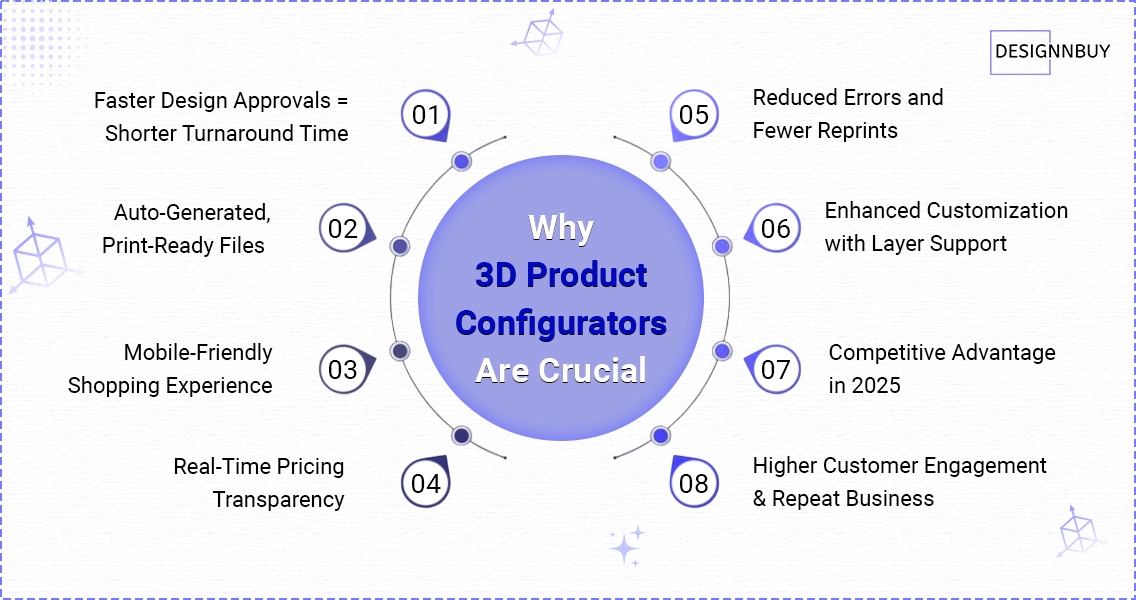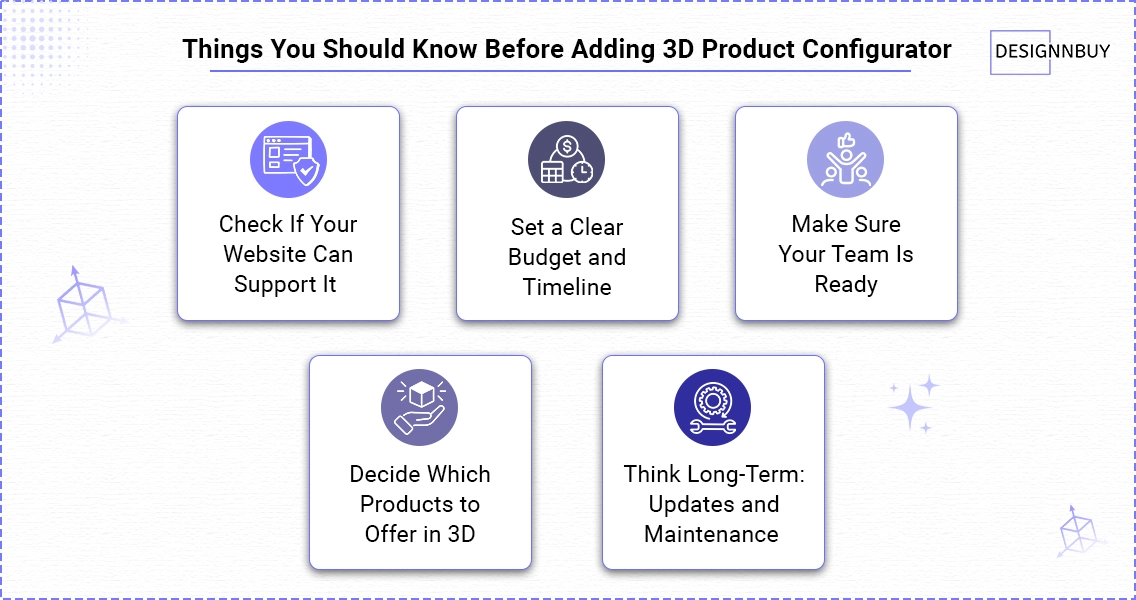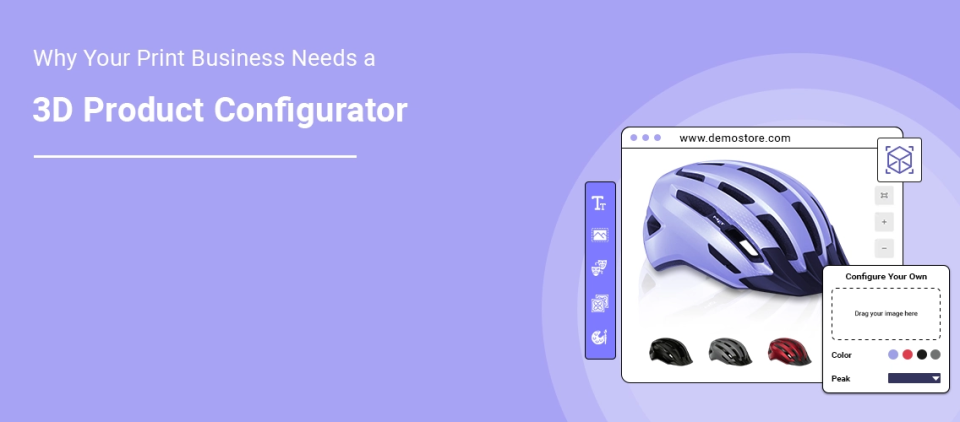The print industry is going through a major transformation, and in 2025, one tool is making more impact than most: the 3D product configurator.
What was once considered a high-tech feature for big-name eCommerce brands is now becoming a must-have for print businesses of all sizes.
Customers today no longer want to imagine how their printed product might look. However, they want to see it, spin it, zoom in, and experience it virtually before they place the order. A 3D product configurator allows just that.
This blog explores why this technology has become a game-changer for the print industry and how your business can benefit from integrating a 3D product configurator into your web-to-print setup
Table of Contents
The Demand for Personalization and Visualization
Customer expectations are higher than ever. In 2025, buyers want complete control over how their products look and feel. They want to see exactly what they’re going to get.
No more flat images or vague product descriptions. A 3D product configurator provides them with a real-time, interactive preview, which makes it easier to build trust and confidence in your brand.
With this technology, customers can rotate the product, zoom in on details, switch colors, upload their own designs, apply finishes, and see how their final product will look in real life.
This level of transparency builds confidence and reduces the chances of order errors or dissatisfaction.
What Is a 3D Product Configurator in Print business?
A 3D product configurator is an interactive digital tool that allows customers to personalize a product and view it in a 360-degree, realistic preview on your website. It transforms your static product listings into dynamic, engaging experiences.
Imagine your customers customizing a bag, adjusting the colors, setting up material, and then seeing how it looks from every angle before they ever click “Buy Now.”
This functionality isn’t just about the wow factor. It also helps streamline your business operations and leads to:
- Faster order approvals
- Fewer design-related mistakes
- Higher customer satisfaction
- Increased average order values
- Greater repeat purchase rates
And importantly, this technology is no longer out of reach. With a modern web-to-print product configurator, even small and mid-sized print businesses can offer a 3D customization experience without heavy investments.
8 Reasons Why 3D Product Configurators Are Crucial in 2025

In 2025, the print industry is undergoing a digital transformation, and 3D product configurators are at the center of it.
An advanced 3D product configurator helps both sides win. Whether you’re offering simple custom prints or complex, layered options, this tool makes the experience smooth, fast, and visually rich.
Here’s why it’s no longer optional in 2025:
1. Faster Design Approvals = Shorter Turnaround Time
In traditional workflows, getting design approvals could take hours or even days. Designers send proofs, clients suggest changes, and teams revise and resend files. This back-and-forth slows everything down.
But with a product 3D configurator, customers view a real-time preview of their custom product while editing. They can instantly visualize color changes, reposition text, or resize graphics, all in an interactive 3D space. Once satisfied, they approve on the spot.
This means fewer delays, faster production, and more satisfied clients.
| With 3D Product Configurator | Without 3D Product Configurator |
|---|---|
| Instant design approvals through live preview | Multiple revisions and back-and-forth communication |
| Customers can finalize confidently | Customers hesitate due to lack of visual clarity |
| Projects move to production faster | Longer turnaround times due to proofing delays |
2. Auto-Generated, Print-Ready Files
Preparing artwork for print is time-consuming and prone to human error. Your team has to check for bleeds, trims, resolution issues, dielines, and more.
3D configurators automate this process. Once a customer confirms their design, the system generates production-ready files, whether it’s a layered PDF, high-res SVG, or dieline-accurate 3D file. No manual cleanup, no missed specs.
This not only reduces errors but also saves hours of prepress time.
| With 3D Product Configurator | Without 3D Product Configurator |
|---|---|
| Print-ready files are generated automatically | Teams manually prepare artwork for print |
| Files include bleeds, dielines, resolutions, layers | High chance of missing specs or setup issues |
| Reduces errors and speeds up production | Slower prepress and higher risk of reprints |
3. Mobile-Friendly Shopping Experience
Over 60% of ecommerce traffic comes from mobile devices and 3D configurators are built to match that behavior. Modern mobile responsive configurators are fully browser-based and mobile-optimized.
Customers can easily rotate, zoom, and customize products using their fingers, whether they’re on a phone or tablet. No apps. No slow load times. Just seamless product personalization from anywhere.
This ensures more conversions and fewer abandoned carts.
| With 3D Product Configurator | Without 3D Product Configurator |
|---|---|
| Smooth customization across devices | Poor experience on mobile devices |
| Customers can design anywhere | Users must switch to desktop to complete orders |
| Higher engagement and conversions | High mobile bounce and abandonment rates |
4. Real-Time Pricing Transparency
Customers hate surprise charges. That’s why real-time dynamic pricing is a game-changer.
As users interact with the configurator—choosing metallic foils, upgrading to rigid boxes, or adding layers—the price updates instantly. They can see how their customizations affect cost, and adjust accordingly.
This builds trust, reduces price-related drop-offs, and increases order values through upsells.
| With 3D Product Configurator | Without 3D Product Configurator |
|---|---|
| Real-time price updates with each customization | Price revealed only at checkout |
| Clear pricing encourages add-ons | Customers may avoid upgrades due to uncertainty |
| Transparent shopping experience | Leads to cart abandonment and lost trust |
5. Reduced Errors and Fewer Reprints
Errors in custom printing can be expensive—both in materials and customer relationships.
3D configurators empower customers to check every detail themselves before placing the order. From spelling errors to alignment issues, they can fix things visually.
Fewer mistakes lead to fewer reprints, which saves you money and strengthens your brand’s reputation.
| With 3D Product Configurator | Without 3D Product Configurator |
|---|---|
| Customers verify and correct mistakes live | Errors often go unnoticed until after printing |
| Fewer returns and costly reprints | High rework and waste from preventable mistakes |
| Better production accuracy and client satisfaction | Poor customer experience due to wrong deliveries |
6. Enhanced Customization with Layer Support
Advanced 3D configurators are not just about customizing bags and Shoes. In 2025, the real value lies in supporting layered products, like luxury packaging, folding cartons, or multi-part kits.
Customers can toggle between surfaces (top, inside, sides), apply finishes (foil, embossing, spot UV), and see how each layer interacts with the others.
This brings complex, high-value print products into the eCommerce world with full clarity and control.
| With 3D Product Configurator | Without 3D Product Configurator |
|---|---|
| Supports multi-surface, layered designs | Only shows basic static templates |
| Enables true packaging visualization | Limited to surface-level decoration |
| Ideal for premium, high-end print products | Not suitable for luxury or structured designs |
7. Competitive Advantage in 2025
As customer expectations evolve, staying ahead of the competition requires smarter tools.
Offering a 3D product configurator shows your business is innovative, customer-focused, and ready for modern commerce. Whether you’re in packaging, apparel, labels, or B2B printing, configurators help you deliver prints faster, better, and with fewer mistakes.
Therefore, in 2025, early adopters will dominate.
| With 3D Product Configurator | Without 3D Product Configurator |
|---|---|
| Engaging, interactive experience | Boring, template-based workflow |
| Customers return for the enjoyable process | Low emotional connection means one-time orders |
| More referrals through word-of-mouth | Less likely to be remembered or recommended |
8. Higher Customer Engagement and Repeat Business
When customers have fun designing their own product and the result looks just like what they imagined, they come back.
A 3D configurator makes the process feel like play. It boosts emotional investment and leaves a lasting impression, which translates into stronger brand loyalty and word-of-mouth marketing.
It also gives your brand a tech-savvy edge.
| With 3D Product Configurator | Without 3D Product Configurator |
|---|---|
| Positions your brand as tech-forward and customer-first | Feels outdated in a digitally evolving market |
| Delivers modern experience customers expect | Can’t compete with brands offering visualization |
| Drives growth through innovation | Misses key trends shaping the industry |
Experience the power of 3D customization. Book your Free Demo with our 3D Product Configurator.
What to Know Before Adding a 3D Product Configurator to Your Store
Adding a 3D product configurator can bring huge benefits to your print business, but it’s not something you can just switch on overnight. It’s important to plan carefully so everything runs smoothly and gives you the results you expect.
Here are the key things you should look at before getting started:

1. Check If Your Website Can Support It
Before anything else, you need to make sure your website and tech setup can handle a 3D configurator.
This means checking if your eCommerce platform (like Shopify, Magento, WooCommerce, etc.) can integrate with the tool, and if your hosting can support 3D content without slowing things down and affecting your SEO.
Also, make sure that it is responsive and works perfectly on mobile screens.
2. Set a Clear Budget and Timeline
3D configurators can range from simple to advanced, and the price depends on how many features you need.
If you want layered customizations, dynamic pricing, and real-time file generation, it may cost more and take longer to launch.
Set a budget early and plan out the timeline. In addition, it includes time for testing, staff training, and any technical setup. It will help you to avoid delays and unexpected costs
3. Make Sure Your Team Is Ready
Everyone on your team, whether it’s sales, customer support, design, or production, should understand how the 3D configurator works and how it fits into their role.
Your support team should be able to help customers if they get stuck. Your print team should be clear on how the files will come in. When everyone is on the same page, it makes the whole process smoother and faster.
4. Decide Which Products to Offer in 3D
Not every product needs a 3D view. Start by picking the ones where seeing the final look really makes a difference, like boxes, labels, packaging, Bags or any item that’s highly customizable.
For each one, you’ll need to decide what parts can be edited (like color, size, material, finish) and how that shows up visually in the configurator.
This planning step helps keep the experience simple and smooth for users.
5. Think Long-Term: Updates and Maintenance
A 3D configurator isn’t a one-time setup. As your business grows and you add new products or make design changes, you’ll need to keep the configurator updated.
Make sure the solution you choose can grow with you, and check if your provider offers regular updates, support, and easy ways to make changes without needing a developer every time.
Final Thoughts
The print industry is evolving rapidly. In a digital-first world, customers expect more than just quality. They expect convenience, control, and confidence.
By adding a 3D product configurator to your online print store, you’re not just modernizing your website; you’re also transforming the entire customer journey.
From faster approvals and error-free orders to higher engagement and repeat business, the impact is undeniable.
With tools like DesignNBuy’s 3D product configurator, integrating this technology into your print workflow is easier and more affordable than ever.
Ready to reshape your print business?
Get your hands on DesignNBuy’s 3D Product Configurator

